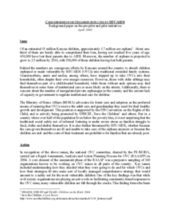Of an estimated 15 million Kenyan children, approximately 1.7 million are orphans. About one-third of them are barely able to comprehend their loss, having not reached five years of age. 650,000 have lost their parents due to AIDS. Moreover, the number of orphans is projected to grow to 2.5 million by 2010, with 500,000 of these children having lost both parents.
Behind the numbers are courageous efforts by Kenyans around the country to absorb children orphaned or made vulnerable by HIV/AIDS (OVCs) into traditional extended family systems. Grand-mothers, aunts and uncles, among others, have stepped up to take OVCs into their households, often despite their own meagre resources. However, those with older siblings may find themselves part of a child-headed household, while those without such options may find themselves in some form of institutional care or more likely on the streets. Additionally, there is concern about the number of unregulated private orphanages in the country and the current lack of capacity in government to regulate institutional care for children.
In recognition of the above issues, the national OVC committee carried out a Rapid Assessment, Analysis and Action Planning Process for OVC (RAAAPP) in 2004. Key issues included understanding how they decided what they were going to do and for which OVCs and how their strategies fit into some sort of locally managed comprehensive strategy that would amount to a safety net for the most vulnerable children. A component of this system would identify remaining vulnerable children and provide their families with a cash subsidy. In Africa, similar approaches have been employed for many years in South Africa and Botswana, while Namibia, Zambia and Tanzania are trying to build comparable schemes.
This background paper outlines the impact of a pre-pilot conditional cash transfer scheme implemented in Kenya and defines key issues to be considered before moving forward into pilot and national schemes. It emphasizes the importance of community involvement and collaboration in implementing a cash transfer system as an additional safety net for orphans and vulnerable children. Questions that arise center on the process of identifying qualifying children and families, the effects of conditionality, and the development of an effective and practical tool for monitoring and evaluation. Several short annexes include possible approaches to answering these questions. This document would be particularly useful for groups looking for a practical model and the issues central to the development and implementation of a cash transfer scheme in an African setting.
©UNICEF

